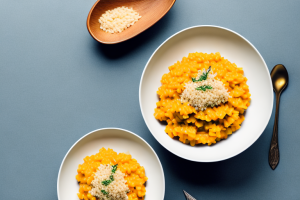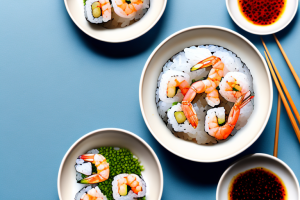How to stir-fry brown rice with snap peas
9 min read
A pan with stir-fried brown rice and snap peas
If you’re looking for a healthy and delicious dish that’s quick and easy to make, stir-fried brown rice with snap peas is an excellent choice. This dish is packed with nutrition and flavor, making it a perfect option for a weeknight dinner or a quick lunch. In this article, we’ll walk you through the essential steps to create this delicious dish, starting with the benefits of using brown rice over white rice.
Why brown rice is a healthier alternative to white rice
While white rice remains a favorite in many households, brown rice is a much healthier option. Brown rice is a whole grain that has not undergone any refining, unlike white rice, which has had its husk, bran, and germ removed. As a result, brown rice retains many of its essential nutrients, including fiber, vitamins, and minerals, that white rice lacks. Additionally, studies have shown that brown rice provides numerous health benefits, including reducing the risk of type-2 diabetes, cancer, and heart disease.
Furthermore, brown rice has a lower glycemic index than white rice, which means it causes a slower and steadier rise in blood sugar levels. This is particularly beneficial for individuals with diabetes or those trying to manage their blood sugar levels. Brown rice also contains more antioxidants than white rice, which can help protect the body against oxidative stress and inflammation.
The nutritional benefits of snap peas
Snap peas are a low-calorie and nutritious vegetable that is rich in essential vitamins and minerals. These crunchy vegetables are a great source of vitamin C, vitamin K, and folate, which supports healthy brain function and reduces the risk of heart disease. Snap peas also contain antioxidants that protect your cells from damage and reduce inflammation in your body. By incorporating snap peas into your stir-fried brown rice, you’re adding a valuable source of nutrition to your meal.
In addition to their nutritional benefits, snap peas are also a versatile vegetable that can be enjoyed in a variety of ways. They can be eaten raw as a snack, added to salads for extra crunch, or cooked in stir-fries and soups. Snap peas are also a great option for those who are looking to increase their vegetable intake without adding too many calories to their diet. So next time you’re at the grocery store, be sure to pick up some snap peas and experiment with different ways to incorporate them into your meals.
Essential tools you need for stir-frying
Before we dive into the recipe itself, let’s talk about the tools you’ll need to make stir-fried brown rice with snap peas. To start, you’ll need a wok or a large skillet with high sides. A wok’s sloping sides and wide shape makes it perfect for stir-frying, but a skillet with high sides will also work well. You’ll also need a wire mesh strainer or colander, a sharp knife, and a cutting board.
In addition to these essential tools, it’s also helpful to have a pair of long-handled tongs or a spatula for stirring and flipping the ingredients in the wok or skillet. A wooden spoon or spatula is also useful for scraping the bottom of the wok or skillet to prevent sticking. Finally, if you’re working with raw meat or poultry, it’s important to have a separate cutting board and knife to avoid cross-contamination with other ingredients.
How to prepare and season brown rice
The first step to making your stir-fried brown rice is to prepare your rice. To do this, measure out your desired quantity of brown rice and rinse it under cold water to remove any excess surface starch. After rinsing, transfer the rice to a pot or rice cooker and add water to cover the rice by about an inch. Cook the rice until tender, then set it aside to cool. Once cool, season the rice with salt, pepper, and a small amount of sesame oil. Stir well to combine.
Did you know that brown rice is a healthier alternative to white rice? Brown rice is a whole grain that contains more fiber, vitamins, and minerals than white rice. It also has a lower glycemic index, which means it can help regulate blood sugar levels.
If you want to add more flavor to your brown rice, you can try adding different herbs and spices. For example, you can add chopped fresh herbs like parsley, cilantro, or basil, or spices like cumin, turmeric, or paprika. You can also add some chopped nuts or dried fruits for a sweet and savory twist.
Tips for cooking perfect snap peas
Cooking snap peas correctly is essential to ensure their flavor and texture aren’t lost in your stir-fry. To cook snap peas, start by washing them under cold water and removing the stem ends. Then, bring a large pot of salted water to a boil over high heat. Add the snap peas and cook for about one minute, or until they turn a bright, vibrant green. Once ready, remove the peas from the pot using a wire mesh strainer or colander and transfer them to an ice bath to stop the cooking process. This blanching technique is the secret to keeping your snap peas crunchy and flavorful in your stir-fry.
Another important tip for cooking snap peas is to avoid overcooking them. Overcooked snap peas can become mushy and lose their bright green color. To prevent this, make sure to keep an eye on the peas while they are cooking and remove them from the heat as soon as they turn bright green.
Additionally, you can add some extra flavor to your snap peas by seasoning them with herbs or spices. Some popular options include garlic, ginger, and sesame seeds. Simply sauté the snap peas with your desired seasonings for a few minutes before adding them to your stir-fry.
Techniques for stir-frying rice and vegetables
Now that your rice and snap peas are prepared and seasoned, it’s time to stir-fry your dish. Start by heating some oil – a high-heat oil such as canola, vegetable, or peanut oil works best – in your wok or skillet. Once hot, add your prepared brown rice and stir-fry for a few minutes to heat it through. Then, add your cooked snap peas and stir-fry for another minute or two until the peas are hot. Add any additional vegetables or proteins at this point and stir-fry for another few minutes until everything is cooked through. Finally, add your desired seasoning, such as soy sauce, oyster sauce, or garlic, and toss everything together until well combined.
One important technique to keep in mind when stir-frying rice and vegetables is to not overcrowd the pan. If you add too much food at once, the temperature of the pan will drop and your ingredients will steam instead of stir-fry. This can result in a soggy and unappetizing dish. To avoid this, cook your ingredients in batches if necessary, and make sure to give them enough space in the pan to cook evenly.
Adding protein to your stir-fry with tofu or chicken
If you’re looking to add some protein to your stir-fry, consider adding tofu or chicken. Both options are a great source of protein and pair well with the dish’s flavors and textures. To do this, start by cutting your chosen protein into small pieces and cooking them separately before adding them to your stir-fry in the final stages. You can cook your protein in the same wok or skillet you’ll be using for your stir-fry, or you can use a separate pan.
Another great option for adding protein to your stir-fry is shrimp. Shrimp cooks quickly and adds a delicious seafood flavor to the dish. To prepare shrimp for your stir-fry, start by cleaning and deveining them. Then, cook them in a separate pan with some oil and garlic until they turn pink. Add them to your stir-fry in the final stages of cooking.
For a vegetarian option, you can also add beans or legumes to your stir-fry. Chickpeas, black beans, and lentils are all great sources of protein and add a hearty texture to the dish. To prepare them, cook them separately and add them to your stir-fry in the final stages of cooking. You can also season them with spices like cumin or chili powder to add some extra flavor.
The best oils to use for stir-frying
When it comes to stir-frying, using the right oil is crucial for achieving excellent results. Look for an oil with a high smoke point, which is the temperature at which the oil starts to smoke and break down. Oils with a high smoke point such as canola, vegetable, and peanut oil are ideal for stir-frying as they can withstand high heat and won’t burn or smoke. Stay away from oils with low smoke points such as olive oil or butter, as they will burn and smoke, affecting the taste and quality of your dish.
Another important factor to consider when choosing an oil for stir-frying is its flavor. While neutral oils like canola and vegetable oil are great for stir-frying, you can also experiment with oils that have a distinct flavor such as sesame oil or coconut oil. These oils can add a unique taste to your dish and enhance the overall flavor profile. Just be sure to use them sparingly as they have a lower smoke point than neutral oils.
How to prevent your stir-fry from becoming soggy or dry
One common issue with stir-frying is that the dish can become either too dry or too soggy. To avoid these issues, ensure you’ve prepared your rice and vegetables beforehand, so you’re not adding too much moisture to the dish. Additionally, make sure your pan or wok is hot enough before adding any ingredients to prevent the food from sweating and becoming soggy. Finally, avoid over-stirring your dish, as this can cause the rice to break down, resulting in a mushy texture.
Another tip to prevent your stir-fry from becoming soggy is to use a slotted spoon to remove any excess liquid from the pan. This will help to keep the vegetables and rice from becoming waterlogged. Additionally, you can add a cornstarch slurry to the dish to thicken the sauce and prevent it from becoming too watery.
If you’re looking to add some extra flavor to your stir-fry, consider using different sauces and seasonings. Soy sauce, oyster sauce, and hoisin sauce are all great options for adding depth and complexity to your dish. You can also experiment with different spices and herbs, such as ginger, garlic, and cilantro, to give your stir-fry a unique and delicious flavor.
Creating a balanced meal with your stir-fry
Stir-fried brown rice with snap peas can be a delicious and healthy meal on its own, but you can also make it part of a larger meal by pairing it with other dishes. Consider serving the dish with a side of steamed vegetables, a small salad, or some grilled protein to create a well-rounded and balanced meal. Adding a source of protein will also help keep you full for longer, making this dish an excellent option for those looking to manage their weight.
Serving suggestions and garnishes for your dish
Finally, let’s talk about the finishing touches for your stir-fried brown rice with snap peas. To add some color and flavor to your dish, consider adding some sliced green onions, chopped cilantro, or toasted sesame seeds as a garnish. You can also serve your stir-fry in a large bowl or plate, making it easier to share if serving to a group.
By following these steps, you can create a delicious and nutritious stir-fried brown rice with snap peas that’s perfect for any meal of the day. With some preparation and a little practice, you’ll be stir-frying like a pro in no time.


